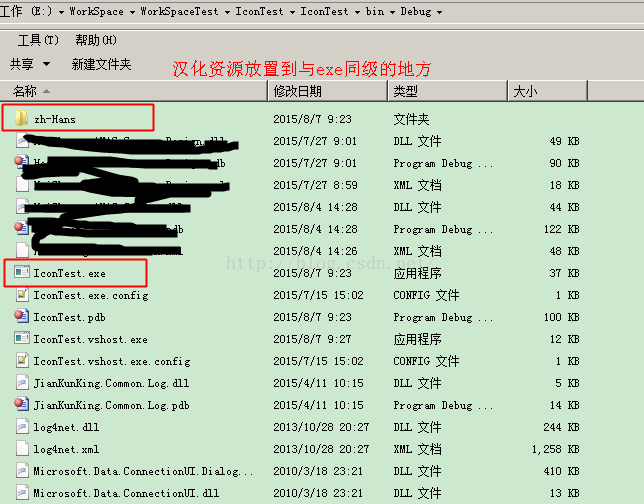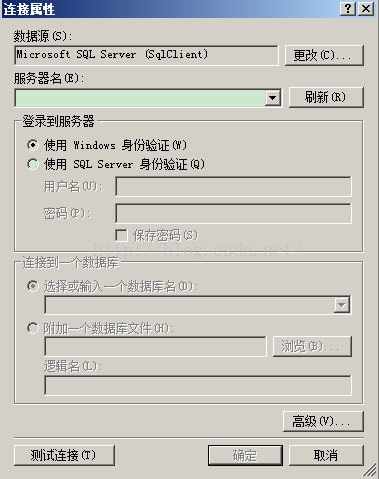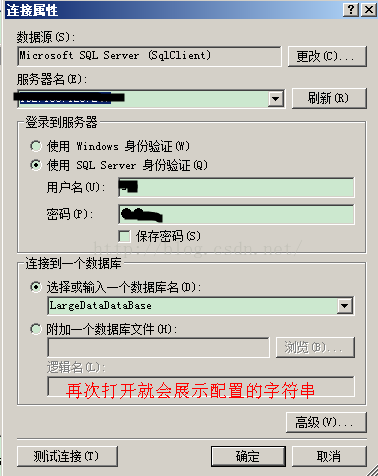 développement back-end
développement back-end
 Tutoriel C#.Net
Tutoriel C#.Net
 Créer une boîte de dialogue de connexion à une base de données universelle à l'aide de la bibliothèque de liens dynamiques de Visual Studio
Créer une boîte de dialogue de connexion à une base de données universelle à l'aide de la bibliothèque de liens dynamiques de Visual Studio
Créer une boîte de dialogue de connexion à une base de données universelle à l'aide de la bibliothèque de liens dynamiques de Visual Studio
1. Recherchez Microsoft dans le répertoire d'installation de VS ("%Visual Studio Installation Directory%/Common10/IDE/Microsoft.Data.ConnectionUI.Dialog.dll") (le fichier de répertoire ici prend vs2010 comme exemple) . Data.ConnectionUI.dll, Microsoft.Data.ConnectionUI.Dialog.dll et le fichier de ressources chinois Microsoft.Data.ConnectionUI.Dialog.resources.dll Notez que les fichiers de ressources chinois doivent être placés dans le dossier zh-CHS ;


2. Ajoutez dans le fichier de projet des références aux deux fichiers dll ci-dessus
3. Le code spécifique est le suivant :
<.>
private void button1_Click(object sender, EventArgs e)
{
DataConnectionDialog dialog = new DataConnectionDialog();
dialog.DataSources.Add(DataSource.AccessDataSource);
dialog.DataSources.Add(DataSource.OdbcDataSource);
dialog.DataSources.Add(DataSource.OracleDataSource);
dialog.DataSources.Add(DataSource.SqlDataSource);
dialog.DataSources.Add(DataSource.SqlFileDataSource);
dialog.SelectedDataSource = DataSource.SqlDataSource;
dialog.SelectedDataProvider = DataProvider.SqlDataProvider;
if (DataConnectionDialog.Show(dialog, this) == DialogResult.OK)
{
//connDlg.ConnectionString;
}
} Affichée à la réouverture, la chaîne de connexion précédemment sélectionnée :
Affichée à la réouverture, la chaîne de connexion précédemment sélectionnée :
DataConnectionDialog dialog = new DataConnectionDialog();
dialog.DataSources.Add(DataSource.AccessDataSource);
dialog.DataSources.Add(DataSource.OdbcDataSource);
dialog.DataSources.Add(DataSource.OracleDataSource);
dialog.DataSources.Add(DataSource.SqlDataSource);
dialog.DataSources.Add(DataSource.SqlFileDataSource);
dialog.SelectedDataSource = DataSource.SqlDataSource;
dialog.SelectedDataProvider = DataProvider.SqlDataProvider;
//之前 DataConnectionDialog 控件保存的连接字符串
dialog.ConnectionString = str;
//ConnectionString有值,则会显示出来
DataConnectionDialog.Show(dialog, this);

Outils d'IA chauds

Undresser.AI Undress
Application basée sur l'IA pour créer des photos de nu réalistes

AI Clothes Remover
Outil d'IA en ligne pour supprimer les vêtements des photos.

Undress AI Tool
Images de déshabillage gratuites

Clothoff.io
Dissolvant de vêtements AI

AI Hentai Generator
Générez AI Hentai gratuitement.

Article chaud

Outils chauds

Bloc-notes++7.3.1
Éditeur de code facile à utiliser et gratuit

SublimeText3 version chinoise
Version chinoise, très simple à utiliser

Envoyer Studio 13.0.1
Puissant environnement de développement intégré PHP

Dreamweaver CS6
Outils de développement Web visuel

SublimeText3 version Mac
Logiciel d'édition de code au niveau de Dieu (SublimeText3)
 Windows 11 prend-il en charge les applications VB6 ?
May 30, 2023 am 08:31 AM
Windows 11 prend-il en charge les applications VB6 ?
May 30, 2023 am 08:31 AM
Windows 11 introduit davantage d'éléments d'interface utilisateur de style macOS. Vous obtenez une barre des tâches repensée avec le menu Démarrer au centre. Oui, vous pouvez modifier sa position, mais par défaut il sera placé au centre. Le centre de contrôle a également reçu quelques modifications de conception. Dans la prochaine mise à jour, la prise en charge des applications Android s'accompagnera également d'un bloc-notes et d'un lecteur multimédia repensés. Même si toutes ces fonctionnalités font de Windows 11 une belle mise à niveau par rapport à Windows 10, certains doutes germent dans l’esprit des utilisateurs. Il existe un segment d'utilisateurs et de développeurs qui se demandent si Windows 11 prendra en charge les applications et technologies héritées, qu'elles soient à la traîne ou non. Depuis V
 Comment réparer l'erreur manquante VCRUNTIME140.dll sous Windows
May 04, 2023 am 08:04 AM
Comment réparer l'erreur manquante VCRUNTIME140.dll sous Windows
May 04, 2023 am 08:04 AM
L'erreur manquante VCRUNTIME140.dll est un problème avec votre fichier redistribuable Visual C++ sous Windows. Vous pouvez utiliser ce tutoriel pour résoudre le problème. Les applications et logiciels Windows nécessitent des fichiers DLL pour s'exécuter. Sans eux, ils pourraient cesser de fonctionner complètement. Par exemple, si vous voyez une erreur VCRUNTIME140.dllmissing, cela indique que ce fichier manque sur votre PC, empêchant le lancement de l'application. Cela peut être dû à l'échec de l'installation de l'application. Il peut même apparaître après l'exécution des mises à jour Windows. Heureusement, vous pouvez facilement
 4 méthodes pour corriger l'erreur CONCRT140.dll introuvable
Apr 25, 2023 am 09:22 AM
4 méthodes pour corriger l'erreur CONCRT140.dll introuvable
Apr 25, 2023 am 09:22 AM
De nombreux utilisateurs ont signalé que chaque fois qu'ils essayaient d'exécuter l'application, un message d'erreur était affiché indiquant que l'exécution du code ne pouvait pas continuer car CONCRT140.dll était introuvable. Lors de l'ouverture d'applications Adobe, Halo, ForzaHorizon5, etc., vous pouvez rencontrer CONCRT140.dll introuvable. Il ne s’agit donc pas d’un problème spécifique à l’application. Sans les DLL appropriées installées, les applications ne fonctionneront pas correctement car leur code dépend du code écrit dans ces bibliothèques. Dans cet article, nous apprendrons ce qu'est CONCRT140.dll et pourquoi il est manquant, et comment nous pouvons le télécharger et corriger l'erreur. qu'est-ce que
 Correction : erreur d'échec de l'installation redistribuable de Microsoft Visual C++ 2015 0x80240017
Apr 18, 2023 pm 01:07 PM
Correction : erreur d'échec de l'installation redistribuable de Microsoft Visual C++ 2015 0x80240017
Apr 18, 2023 pm 01:07 PM
Microsoft Visual C++ fait désormais partie intégrante du système d'exploitation Windows requis pour exécuter les applications les plus courantes. Désormais, certains utilisateurs se sont récemment plaints des problèmes rencontrés lors de la tentative d'installation des packages redistribuables Visual C++ pour 2015 ou des packages redistribuables Microsoft Visual Studio pour 2013. Selon ces utilisateurs, le programme d'installation s'est arrêté à mi-chemin et a affiché « 0x80240017 - Erreur non spécifiée ». Cet échec peut avoir plusieurs raisons. Alors ne fais pas ça
 Visual Studio 2022 pour Mac 17.0 est livré avec l'interface utilisateur native de macOS et la prise en charge d'Apple Silicon
Apr 15, 2023 am 08:04 AM
Visual Studio 2022 pour Mac 17.0 est livré avec l'interface utilisateur native de macOS et la prise en charge d'Apple Silicon
Apr 15, 2023 am 08:04 AM
Microsoft a annoncé la sortie générale de Visual Studio 2022 pour Mac 17.0. Il apporte d’énormes changements, notamment une interface utilisateur macOS native et la prise en charge des processeurs Apple Silicon. Selon la société, elle a également publié une nouvelle version d'aperçu que vous pouvez installer côte à côte avec cette version. Dans les anciennes versions de Visual Studio pour Mac, Microsoft utilisait diverses techniques d'interface utilisateur qui donnaient l'impression que les choses n'étaient pas à leur place. Cette mise à jour utilise
 Comment Android Studio télécharge-t-il des images sur le serveur Java
Apr 28, 2023 pm 09:07 PM
Comment Android Studio télécharge-t-il des images sur le serveur Java
Apr 28, 2023 pm 09:07 PM
1.build.gradle configuration (augmentation) des dépendances{implementation'com.squareup.okhttp3:okhttp:4.9.0'implementation'org.conscrypt:conscrypt-android:2.5.1'} 2.AndroidManifest.xml configure les autorisations dans l'application Ajouter Android :usesCleartextTraffic="true&q
 Microsoft publie Visual Studio 2022 17.3, voici les points forts
Apr 28, 2023 am 10:28 AM
Microsoft publie Visual Studio 2022 17.3, voici les points forts
Apr 28, 2023 am 10:28 AM
Microsoft a publié Visual Studio 202217.3. Cette mise à jour apporte la prise en charge de l'interface utilisateur des applications multiplateformes .NET (.NETMAUI), la possibilité de développer des applications pour Microsoft Teams, des améliorations C++, Azure Container Apps et des tests unitaires en direct améliorés. Vous pouvez voir la liste complète des nouvelles fonctionnalités en ouvrant Aide > Nouveautés dans Visual Studio. La principale fonctionnalité de cette mise à jour est que .NETMAUI n'est plus pris en charge en version préliminaire et est désormais disponible dans Visual Studio 2022 sous Windows.
 Comment résoudre le problème selon lequel Android Studio ne peut pas exécuter la méthode principale de la classe Java
May 17, 2023 pm 04:43 PM
Comment résoudre le problème selon lequel Android Studio ne peut pas exécuter la méthode principale de la classe Java
May 17, 2023 pm 04:43 PM
Environnement version Androidstudio : 3.6.1 version gradle : 5.6.4 version du plug-in gradle : 3.6.1 Invite d'erreur 23:41:35 : Executingtask'TxtUtil.main()'...Executingtasks:[TxtUtil.main()] inproject/Users/tinytongtong/Documents/workspace/as/self/BlogDemoFAILURE:Buildfailedwithanexception.*Wh





